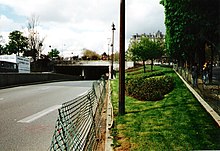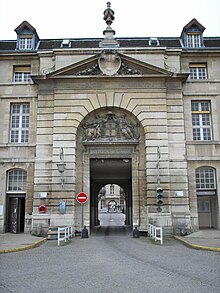Conspiracy theories about the death of Diana, Princess of Wales
[1] Official investigations in both Britain and France found that Diana died in a manner consistent with media reports following the fatal car crash in Paris.
[3][4] After hearing evidence at the British inquest, a jury in 2008 returned a verdict of "unlawful killing" by driver Henri Paul and the paparazzi pursuing the car.
"[6] Active in disputing the official version of events were the British tabloid newspaper, the Daily Express,[7][8] and Egyptian businessman, Mohamed Al-Fayed, whose son, Dodi, was Diana's partner at the time and also died in the crash.
[9][10][11] She had allegedly expressed similar concerns in October 1995 to Lord Mishcon, her solicitor, that "reliable sources" had told her "that she and Camilla would be put aside" for Charles to marry Tiggy Legge-Bourke.
[12] A special Metropolitan Police inquiry team was established in 2004, Operation Paget, headed by Commissioner John Stevens to investigate the various conspiracy theories which led to the British inquest.
In response, French authorities carried out a third test, this time using the more medically conclusive vitreous fluid from inside the eye, which confirmed the level of alcohol measured by blood and also showed Paul had been taking antidepressants.
[25] Under cross-examination at the British inquest in 2008, Stevens denied "deliberately misleading" Paul's parents and said that the chauffeur's condition at the time of the crash did not match the police's definition of being drunk, which he said relied upon someone's physical responses.
One of the main motives which has been advanced for alleged murder includes suggestions Diana was pregnant with Mohamed "Dodi" Fayed's child and the couple were about to get engaged.
The alleged dislike of the idea of a non-Christian within the British royal family meant such a relationship between the mother of the future king and an Egyptian Muslim would not be tolerated.
[45] Jeffrey Steinberg of the Executive Intelligence Review (EIR), a publication of the American Lyndon LaRouche movement, has also put forward theories that the Princess of Wales was murdered by the security services under the instructions of Prince Philip.
Operation Paget commented that an announcement of such magnitude from the Princess of Wales would have been a substantial media event of worldwide interest and would have required significant preparation.
[50] Alberto Repossi said in 2003 that the ring had been placed on Diana's finger in a St Tropez hotel, and was being resized for future collection in Paris, but later admitted to writer Martyn Gregory that he had received "legal papers" from Al-Fayed, a client for more than 20 years.
"[31] Diana's former private secretary, Patrick Jephson, said to the BBC in reaction to the publication of the Operation Paget Report in December 2006 that her facial expression in the CCTV footage of her at the Paris Ritz on her final evening with Dodi Fayed was one she would wear when she was disgruntled with a situation.
Cross-examined at the inquest on February 14, he conceded that he had found no evidence of a criminal conspiracy to kill the Princess, or that she was engaged or pregnant at the time of her death, apart from the claims Al-Fayed had relayed to him.
[62] In an effort to examine the assertions made by Al-Fayed, Operation Paget had scientific tests carried out on pre-transfusion blood found in the footwell of the seat in the wrecked Mercedes the Princess of Wales occupied at the time of the crash.
A security guard at the villa, Reuben Murrell, felt uncomfortable lying about the matter and sold his story to The Sun stating that the visit lasted just under thirty minutes and was not in the company of any interior designer.
Lieutenant Eric Gigou of the Brigade Criminelle led the team that carried out that work, initially by retracing the route several times and drawing up a list of possible locations.
Officers in the Police Headquarters Information and Command Centre could continue to view the pictures shown by the traffic camera in real time but could not control it.
[73] Mohamed Al-Fayed alleged in his July 2005 statement to Operation Paget, and at other times, that the white Fiat Uno was being used by MI6[74] as a means of causing the Mercedes to swerve and thereby crash into the side of the tunnel.
French police had examined Andanson's car as part of their effort to trace the one that had come into contact with the Mercedes with a view to prosecuting the driver for failing to render assistance and had reached the same conclusion.
Andanson had been interviewed by French police in February 1998, and had been able to provide documentary evidence about his movements on the previous 30th and 31st of August which had satisfied them that he could not have been the driver of the Fiat Uno involved.
[81] Operation Paget found no evidence Andanson was known to any security service and, contrary to Al-Fayed's claims, his death was thoroughly investigated by French police (although the whereabouts of the car keys has never been explained).
[82] It has been reported by numerous publications that the white Fiat Uno belonged to Le Van Thanh, a taxi driver who was 22 years old at the time of the crash.
The French system of emergency care adhered to the "stay and play" mantra, which meant that the patient needed to be stabilised first at a fully equipped medical ambulance before being directed to a specialised hospital that could treat his or her injuries, no matter how far away it was.
The decision to transfer her to the Pitié-Salpêtrière Hospital was taken by Marc Lejay who was on despatch duty in SAMU Control on that night, in consultation with Dr Derossi, who was at the scene.
[105] Mohamed Al-Fayed alleged that Diana's body was deliberately embalmed shortly after her death to ensure that any pregnancy test at the post-mortem would produce a false result.
Robert Chapman, who carried out the post-mortem examination, stated that the embalming fluids would have had no effect on determining whether Diana was pregnant or not as the physical evidence would have been present in her womb and ovaries.
Faced with this situation, the hospital staff decided to press ahead with embalming with only verbal authority from Martine Monteil, the local superintendent of police, who assured Jean Monceau "that everything would be in order".
[107] The Court Martial of SAS Sniper Danny Nightingale led to a letter written by witness, Soldier N, and sent to his in-laws coming to wider attention.
At the end of November 2013, Scotland Yard ended its study of the SAS allegations and released a statement: "The Metropolitan Police Service has scoped the information and is in the process of drawing up conclusions, which will be communicated to the families and interested parties first, before any further comment can be made,"[112] On 16 December, it emerged from Sky News reports that there was "no credible evidence" that the SAS was involved in the death of the Princess and the others, and thus no reason to re-open the investigation.




